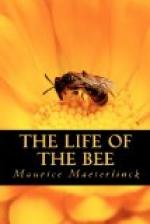[59]
Were it our desire to throw light upon all the secrets of this geometric architecture, we should have more than one curious question still to consider; as for instance the shape of the first cells, which, being attached to the roof, are modified in such a manner as to touch the roof at the greatest possible number of points.
The design of the principal thoroughfares is determined by the parallelism of the combs; but we must admire the ingenious construction of alleys and gangways through and around the comb, so skilfully contrived as to provide short cuts in every direction and prevent congestion of traffic, while ensuring free circulation of air. And finally we should have to study the construction of transition cells, wherein we see a unanimous instinct at work that impels the bees at a given moment to increase the size of their dwellings. Three reasons may dictate this step: an extraordinary harvest may call for larger receptacles, the workers may consider the population to be sufficiently numerous, or it may have become necessary that males should be born. Nor can we in such cases refrain from wondering at the ingenious economy, the unerring, harmonious conviction, with which the bees will pass from the small to the large, from the large to the small; from perfect symmetry to, where unavoidable, its very reverse, returning to ideal regularity so soon as the laws of a live geometry will allow; and all the time not losing a cell, not suffering a single one of their numerous structures to be sacrificed, to be ridiculous, uncertain, or barbarous, or any section thereof to become unfit for use. But I fear that I have already wandered into many details that will have but slender interest for the reader, whose eyes perhaps may never have followed a flight of bees; or who may have regarded them only with the passing interest with which we are all of us apt to regard the flower, the bird or the precious stone, asking of these no more than a slight superficial assurance, and forgetting that the most trivial secret of the non-human object we behold in nature connects more closely perhaps with the profound enigma of our origin and our end, than the secret of those of our passions that we study the most eagerly and the most passionately.




